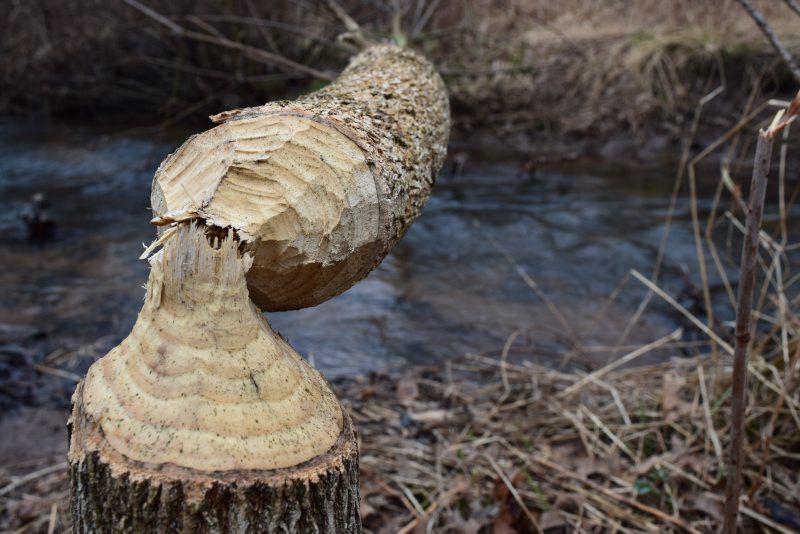Lots more headlines this morning about the Wisconsin Beaver-trapping bruhaha. One of them titled “Beaver-drowning traps removed” which is the greatest indication I know that someone from PETA is pushing the story forward. I am a very picky advocate, so I want to demand “so if the beavers were instantly crushed and not drowned, that would be okay?” But I guess there are a lot of right ways to be a beaver advocate. And not wanting animals to suffer is certainly one of them. I of course want them to live, right where they are, and do good things for our waterways and wildlife.
Meanwhile, I was pleasantly surprised this morning to see this headline from the Times-Telegraph in Herkimer, NY.
Local Beaver experts present at Oregon conference
 DOLGEVILLE, N.Y. — Owen Brown, president of Beavers: Wetlands & Wildlife, and Sharon Brown, BWW biologist, presented “Forty Years Working for Beavers” at the State of the Beaver 2017 conference in Canyonville, Oregon, in February.
DOLGEVILLE, N.Y. — Owen Brown, president of Beavers: Wetlands & Wildlife, and Sharon Brown, BWW biologist, presented “Forty Years Working for Beavers” at the State of the Beaver 2017 conference in Canyonville, Oregon, in February.
They represented Beavers: Wetlands & Wildlife, an educational non-profit based in Dolgeville, that was inspired by Beaver Woman Dorothy Richards, who studied the species for 50 years.
This, the fifth State of the Beaver conference, attracted 200 participants from many states as well as from Canada, Germany, Wales, England and Scotland. It was sponsored by the Cow Creek Band of the Umpqua Tribe, and held at their Seven Feathers Casino.
“It was a special place,” said Owen Brown, “and a special gathering of people who are interested in the animal that can help solve our most serious environmental problems.”
By building dams, beavers restore wetlands that increase biodiversity, decrease damage from flash floods and greatly reduce water pollution.
Beavers: Wetlands & Wildlife solves conflicts between people and beavers so that the beavers and their beneficial wetlands are saved.
The theme of this year’s conference was “Beaver — Agent of Regeneration.” After the event, the Browns accompanied Mike Callahan, of Massachusetts-based Beaver Solutions, and Vanessa Petro, an Oregon State University biologist, to see a beaver flow device at a forested wetland near Corvallis, Oregon.
Whooohoo! Great job Sharon and Owen! If only every presenter at the conference showed up in their local paper after coming back from the conference. There would be such a glut of good beaver news I wouldn’t know where to start first! I’m sorry I missed their presentation and am lucky I was able to get the meticulous notes Sherry Guzzi took there and hear all about it. I went looking for the summary of their presentation this morning and found that the website had already been updated for the 2019 conference. Way to plan ahead guys. Reserve your spot today!
Yesterday I got to have one of my favorite conversations of the year, when I talked with Amelia Hunter about the beaver brochure for this year’s festival. I usually have a few ideas that I ping off her like a cheerful artistic cell tower. This time I was interested in showing beaver work, water, and some background. In fact I thought the MIT class ring was a perfect place to start.
 We got talking about the skyline in the background and Amelia suggested wouldn’t it be cool to replace it with Martinez landmarks instead? Since it was our tenth bea-versary. What an awesome idea! I suggested the John Muir House and the arch/rainbow bridge down at the wharf. She was intrigued and said she’d start playing. We are so lucky that she still wants to help us after SO many years.
We got talking about the skyline in the background and Amelia suggested wouldn’t it be cool to replace it with Martinez landmarks instead? Since it was our tenth bea-versary. What an awesome idea! I suggested the John Muir House and the arch/rainbow bridge down at the wharf. She was intrigued and said she’d start playing. We are so lucky that she still wants to help us after SO many years.
I can’t wait to see how this turns out!



 So now you have PETA telling you to wrap trees and a whole lot more folks calling your office I bet. I know I spent my first hour of the day writing the editor, the parks and the mayor. Stories like this never fail to delight me. It’s like playing the same waltz grandma danced to when she was a girl.
So now you have PETA telling you to wrap trees and a whole lot more folks calling your office I bet. I know I spent my first hour of the day writing the editor, the parks and the mayor. Stories like this never fail to delight me. It’s like playing the same waltz grandma danced to when she was a girl. What? You mean there might be BENEFITS to having beavers in the area? You don’t say! Tell me more! This retired officer knows her stuff. I just wish I were a young student in Madison that could be hopping aboard this particular train and bringing some friends. Don’t you?
What? You mean there might be BENEFITS to having beavers in the area? You don’t say! Tell me more! This retired officer knows her stuff. I just wish I were a young student in Madison that could be hopping aboard this particular train and bringing some friends. Don’t you?




 Beavers are found across much of North America, almost anywhere there’s water and wood. They are well-established in most areas of Pennsylvania.
Beavers are found across much of North America, almost anywhere there’s water and wood. They are well-established in most areas of Pennsylvania. Dubbed beaver dam analogues, these structures can be built with hand labor. Even volunteers and children can get involved — no heavy machinery required.
Dubbed beaver dam analogues, these structures can be built with hand labor. Even volunteers and children can get involved — no heavy machinery required.


































